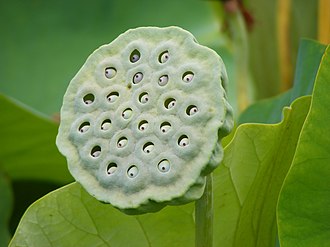Trypophobia
Fear of clusters of small holes or bumps

Trypophobia is an aversion to the sight of irregular patterns or clusters of small holes or bumps. Although not officially recognized as a mental disorder, it is a condition that can cause significant discomfort and anxiety in those affected.
Etymology[edit]
The term "trypophobia" is derived from the Greek words "trypa," meaning hole, and "phobos," meaning fear. It was coined in 2005 by an online community.
Symptoms[edit]
Individuals with trypophobia may experience a range of symptoms when exposed to triggering images or objects. These symptoms can include:
- Feelings of discomfort or disgust
- Goosebumps
- Itching
- Nausea
- Sweating
- Panic attacks
Causes[edit]
The exact cause of trypophobia is not well understood. Some researchers suggest it may be an evolutionary response to avoid disease or danger, as many poisonous animals and infectious diseases are associated with patterns similar to those that trigger trypophobia.
Research[edit]
Studies have shown that trypophobia is more common than previously thought, with a significant portion of the population experiencing some level of discomfort when viewing trypophobic images. Research is ongoing to better understand the psychological and neurological basis of this condition.
Treatment[edit]
There is no specific treatment for trypophobia, but cognitive-behavioral therapy (CBT) and exposure therapy may help individuals manage their symptoms. Relaxation techniques and mindfulness may also be beneficial.
Related pages[edit]
Trypophobia[edit]
Ad. Transform your life with W8MD's Budget GLP-1 injections from $75


W8MD offers a medical weight loss program to lose weight in Philadelphia. Our physician-supervised medical weight loss provides:
- Weight loss injections in NYC (generic and brand names):
- Zepbound / Mounjaro, Wegovy / Ozempic, Saxenda
- Most insurances accepted or discounted self-pay rates. We will obtain insurance prior authorizations if needed.
- Generic GLP1 weight loss injections from $75 for the starting dose.
- Also offer prescription weight loss medications including Phentermine, Qsymia, Diethylpropion, Contrave etc.
NYC weight loss doctor appointmentsNYC weight loss doctor appointments
Start your NYC weight loss journey today at our NYC medical weight loss and Philadelphia medical weight loss clinics.
- Call 718-946-5500 to lose weight in NYC or for medical weight loss in Philadelphia 215-676-2334.
- Tags:NYC medical weight loss, Philadelphia lose weight Zepbound NYC, Budget GLP1 weight loss injections, Wegovy Philadelphia, Wegovy NYC, Philadelphia medical weight loss, Brookly weight loss and Wegovy NYC
|
WikiMD's Wellness Encyclopedia |
| Let Food Be Thy Medicine Medicine Thy Food - Hippocrates |
Medical Disclaimer: WikiMD is not a substitute for professional medical advice. The information on WikiMD is provided as an information resource only, may be incorrect, outdated or misleading, and is not to be used or relied on for any diagnostic or treatment purposes. Please consult your health care provider before making any healthcare decisions or for guidance about a specific medical condition. WikiMD expressly disclaims responsibility, and shall have no liability, for any damages, loss, injury, or liability whatsoever suffered as a result of your reliance on the information contained in this site. By visiting this site you agree to the foregoing terms and conditions, which may from time to time be changed or supplemented by WikiMD. If you do not agree to the foregoing terms and conditions, you should not enter or use this site. See full disclaimer.
Credits:Most images are courtesy of Wikimedia commons, and templates, categories Wikipedia, licensed under CC BY SA or similar.
Translate this page: - East Asian
中文,
日本,
한국어,
South Asian
हिन्दी,
தமிழ்,
తెలుగు,
Urdu,
ಕನ್ನಡ,
Southeast Asian
Indonesian,
Vietnamese,
Thai,
မြန်မာဘာသာ,
বাংলা
European
español,
Deutsch,
français,
Greek,
português do Brasil,
polski,
română,
русский,
Nederlands,
norsk,
svenska,
suomi,
Italian
Middle Eastern & African
عربى,
Turkish,
Persian,
Hebrew,
Afrikaans,
isiZulu,
Kiswahili,
Other
Bulgarian,
Hungarian,
Czech,
Swedish,
മലയാളം,
मराठी,
ਪੰਜਾਬੀ,
ગુજરાતી,
Portuguese,
Ukrainian
